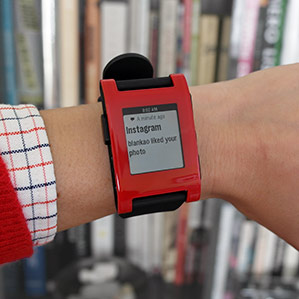Pebble Sets Sights on Fitness Trackers with New App-Making Tools
Smart watch maker Pebble unveiled updates on Wednesday to the software tools that developers can use to build apps for its wrist-worn device. The tools extend the watch’s capabilities and may put it in more direct competition with popular fitness-tracking devices like the Jawbone Up and the Nike Fuelband.

The changes come as a growing number of smart watch makers like Samsung and Sony and fitness-tracking competitors like Jawbone and Nike jostle for consumers’ wrists. The push also shows that Pebble recognizes the role that simple sensing could play in the emergence of more broadly appealing wearable computers (see “So Far, Smart Watches Are Pretty Dumb”).
While not the first smart watch on the market, the $150 Pebble was the first to really resonate with consumers and app makers. Last year, the company raked in $10 million on the crowdfunding site Kickstarter for its gadget, which connects to your smartphone and buzzes to alert you of incoming calls and messages. About 190,000 Pebble watches have been sold.
From the start, Pebble hoped that most of the watch’s functionality would come from third-party developers. But speaking in San Francisco this week, Pebble founder and CEO Eric Migicovsky said that, in the early days, the company’s biggest goal was simply to ship the watch to its tens of thousands of Kickstarter backers.
The software development kit (SDK), officially released in April, was “definitely an alpha” version that Pebble “pushed out kind of to see what people would do with it,” he said. That kit led to the development of over 2,000 apps ranging from simple watch faces and games to remote controls, but there was clearly a lot of work still to be done. “The bug request line was ringing,” Migicovsky said.
The new SDK gives developers the option to add motion- and gesture-tracking features to Pebble apps. Several sports-related apps are already available for the Pebble, but they aren’t able to take advantage of the watch’s accelerometer.
Developers will also be able to build apps that can cache a small amount of data on the watch when the owner’s smartphone is out of range and automatically transfer it to the smartphone later on. These features could help deal with dropped Bluetooth connections and could be useful for tracking activities like swimming and running, where the user is typically separated from his phone.
Additionally, Migicovsky said, the new SDK will make it easier for developers to build Pebble apps that work with both the iPhone and Android smartphones.
Pebble is also bringing in more established companies as app developers. The company said on Wednesday that it will be adding apps from Yelp and Foursquare, among others. Pebble will roll out a software update for users before the end of the year that will enable apps with these new features to work on existing watches, and these apps will become available at that time as well.
Also on Wednesday, Pebble announced an update to its smart watch software for customers who use the Pebble with an iPhone. It will let users choose to see any app notifications on their Pebble that they’ve elected to see on their iPhone. Previously, iOS notifications on the Pebble had been limited to just a handful of functions including calls, e-mails, and texts.
Keep Reading
Most Popular
Large language models can do jaw-dropping things. But nobody knows exactly why.
And that's a problem. Figuring it out is one of the biggest scientific puzzles of our time and a crucial step towards controlling more powerful future models.
The problem with plug-in hybrids? Their drivers.
Plug-in hybrids are often sold as a transition to EVs, but new data from Europe shows we’re still underestimating the emissions they produce.
Google DeepMind’s new generative model makes Super Mario–like games from scratch
Genie learns how to control games by watching hours and hours of video. It could help train next-gen robots too.
How scientists traced a mysterious covid case back to six toilets
When wastewater surveillance turns into a hunt for a single infected individual, the ethics get tricky.
Stay connected
Get the latest updates from
MIT Technology Review
Discover special offers, top stories, upcoming events, and more.